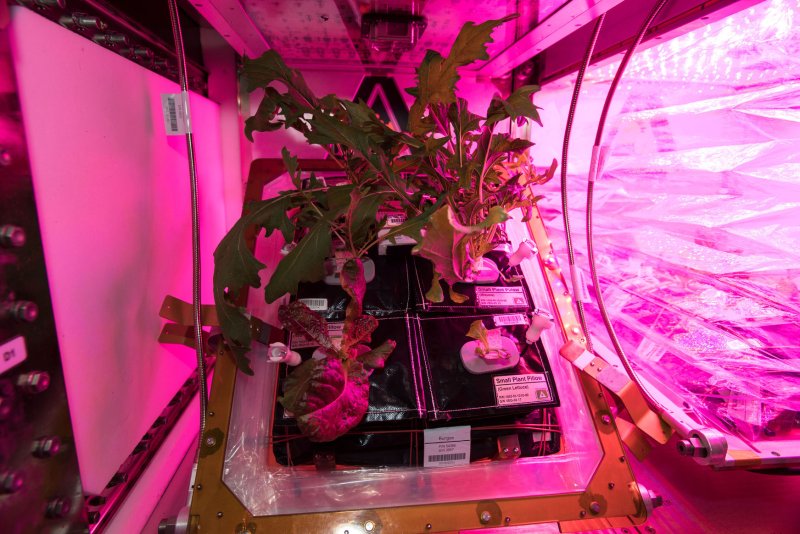The crew aboard the International Space Station has grown batches of mixed greens -- mizuna, red romaine lettuce and Tokyo bekana cabbage -- and further research has found it is safe to eat, even though astronauts have already used it for salads. Photo by NASA/UPI |
License Photo
March 6 (UPI) -- Astronauts onboard the International Space Station have successfully cultivated lettuce and, according to a study published Friday, the red romaine lettuce -- a Lactuca sativa variety known as 'Outredgeous' -- is disease-free and safe to eat.
Currently, astronauts must go without fresh produce. All of their meals are sterilized for the trip to space by heating, freeze drying or irradiation. Nutrients tend to degrade during long-term storage.
In addition to offering a reprieve from the monotony of freeze-dried meals, fresh lettuce would provide a nutritional boost. The red romaine lettuce contains potassium as well as vitamins K, B1, and C.
NASA officials have previously pinpointed growing crops in space as an essential part of long-term space missions, such as a human outpost on the moon or a trip to Mars.
"The ability to grow food in a sustainable system that is safe for crew consumption will become critical as NASA moves toward longer missions," lead study author Christina Khodadad, researcher at the Kennedy Space Center, said in a news release. "Salad-type, leafy greens can be grown and consumed fresh with few resources."
The lettuce was grown from surface-sterilized seeds inside a chamber specifically designed for space-based crops. Scientists outfitted the Vegetable Production Systems, dubbed "Veggie," with LED lighting and a watering system. The lettuce was allowed to grow undisturbed for 33 to 56 days before being deep-frozen and readied for shipment back to Earth.
Scientists grew a control crop at Kennedy Space Center's laboratories under conditions similar to those found inside the space station.
When they compared the harvests, scientists found the space lettuce was similar in composition. However, some of the space lettuce boasted higher concentrations of vitamins and other compounds, including potassium, sodium, phosphorus, sulphur and zinc. Researchers also measured elevated levels of phenolics in the space lettuce, molecules that boast antiviral, anticancer, and anti-inflammatory properties.
Researchers also used next-generation DNA sequencing technology to identify the communities of fungi and bacteria living on the space lettuce. They found the 15 most abundant microbial genera on the space lettuce leaves were similar to those living on the control crop. Fungi and bacteria living on the roots of the two crops were also similar. The sequencing revealed no bacteria genera known to cause disease in humans.
As scientists confirmed in the paper, published in the journal Frontiers in Plant Science, the red romaine lettuce grown on the International Space Station is safe to eat.
Astronauts already knew as much, anecdotally, as several space station crew members ate a salad before sending the rest of the harvest back to Earth for study. There were no ill effects. But the official findings bode well for the future of crop cultivation in space.
"The International Space Station is serving as a test bed for future long-duration missions, and these types of crop growth tests are helping to expand the suite of candidates that can be effectively grown in microgravity," said study co-author Gioia Massa, project scientist at Kennedy Space Center. "Future tests will study other types of leafy crops as well as small fruits like pepper and tomatoes, to help provide supplemental fresh produce for the astronaut diet."















